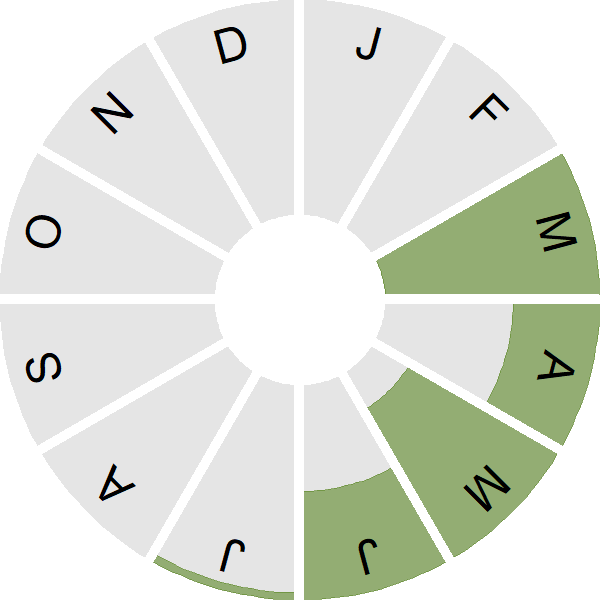Iberian Chiffchaff
Introduction
Only recently separated from Common Chiffchaff (on the basis of DNA and its distinctive song) this is a rare spring visitor to southern Britain.
Key Stats
Status and Trends
Conservation Status
Population Size
Population Change
This species was split from Common Chiffchaff in 1999 (BOU 1999) and singing males have been reported in very small numbers in recent years (Eaton et al. 2021), with breeding confirmed in 2015 (Hunter 2016). The species may possibly be in the early stages of colonising the UK.
Distribution
This species is a rare vagrant and was recorded during Bird Atlas 2007–11 as shown on the map.
Occupied 10-km squares in UK
2008–11
or view it on Bird Atlas Mapstore.
Distribution Change
This vagrant is too rarely reported to map distribution change.
Seasonality
Iberian Chiffchaff is a spring vagrant.
Weekly pattern of occurrence
The graph shows when the species is present in the UK, with taller bars indicating a higher likelihood of encountering the species in appropriate regions and habitats.

Movement
Britain & Ireland movement
Biology
Survival and Longevity
Survival is shown as the proportion of birds surviving from one year to the next and is derived from bird ringing data. It can also be used to estimate how long birds typically live.
Classification, names and codes
Classification and Codes
- Order: Passeriformes
- Family: Phylloscopidae
- Scientific name: Phylloscopus ibericus
- Authority: Ticehurst, 1937
- BTO 2-letter code: IR
- BTO 5-letter code: IBECH
- Euring code number: 13115
Alternate species names
- Catalan: mosquiter ibèric
- Czech: budnícek iberský
- Danish: Iberisk Gransanger
- Dutch: Iberische Tjiftjaf
- Estonian: ibeeria väike-lehelind
- Finnish: iberiantiltaltti
- French: Pouillot ibérique
- German: Iberienzilpzalp
- Hungarian: ibériai füzike
- Icelandic: Grenisöngavri
- Italian: Luì piccolo iberico
- Latvian: Iberijas cuncinš
- Lithuanian: iberine pecialinda
- Norwegian: Iberiagransanger
- Polish: swistunka iberyjska
- Portuguese: felosinha-ibérica
- Slovak: kolibiarik iberský
- Slovenian: iberska listnica
- Spanish: Mosquitero ibérico
- Swedish: iberisk gransångare
- Welsh: Siff-siaff Iberia
Research
Causes of Change and Solutions
Causes of change
As this species has only recently been recognised it is unclear whether its status in the UK has changed. It is possible that records will become more frequent in the future as a result of climate change.
More Evidence
More evidence from Conservation Evidence.com
Partners
Citing BirdFacts
If you wish to cite particular content in this page (e.g. a specific value) it is best to use the original sources as linked in the page. For a more general citation of the whole page please use: BTO (20XX) BirdFacts Species: profiles of birds occurring in the United Kingdom. BTO, Thetford (www.bto.org/birdfacts, accessed on xx/xx/xxxx).

